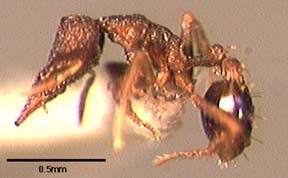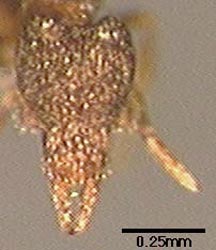Neostruma aethegenys Bolton ms
This manuscript name is a conditional proposal by B. Bolton (sensu Article 15 of the 1985 ICZN), and thus not made available here. Its appearance here or in any duplication of this page does not constitute publication (sensu Article 8 of the 1985 ICZN).
Formicidae, Hymenoptera, Insecta, Arthropoda, Animalia

Specimen: Costa Rica, Prov. Puntarenas: Osa Peninsula, JTL2760-s, INBIOCRI001283198. Image by J. Longino.
Identification
Vertex with prominent transverse ridge; a unique feature of this species.
|

Specimen: Costa Rica, Prov. Puntarenas: Osa Peninsula, JTL2760-s, INBIOCRI001283198. Image by J. Longino. |
Range
Costa Rica (southern Atlantic and southern Pacific lowlands).
Natural History
Brown (1959) characterizes the genus as a whole as forming
"small colonies, chiefly in the leaf litter of rain forest or tropical evergreen forest, and nests occupy cavities in rotting twigs, pieces of bark or similar forest-floor vegetable debris... The food... consists primarily of small entomobryomorph Collembola and possibly some other minute terrestrial arthropods as well. Hunting behavior is like that of Smithistruma rather than like the Strumigenys so far studied."
Selected Records
Prov. Puntarenas, Osa Peninsula, Rancho Quemado (Longino). Winkler sample from lowland rainforest.
Prov. Limon, 3km SSE Cahuita (P. S. Ward #6530).
Literature Cited
Brown, W. L., Jr. 1959. A revision of the Dacetine ant genus Neostruma. Breviora 107:1-13.
John T. Longino, The Evergreen State College, Olympia WA 98505
USA.
longinoj@evergreen.edu
Last modified: 10 June 1997

